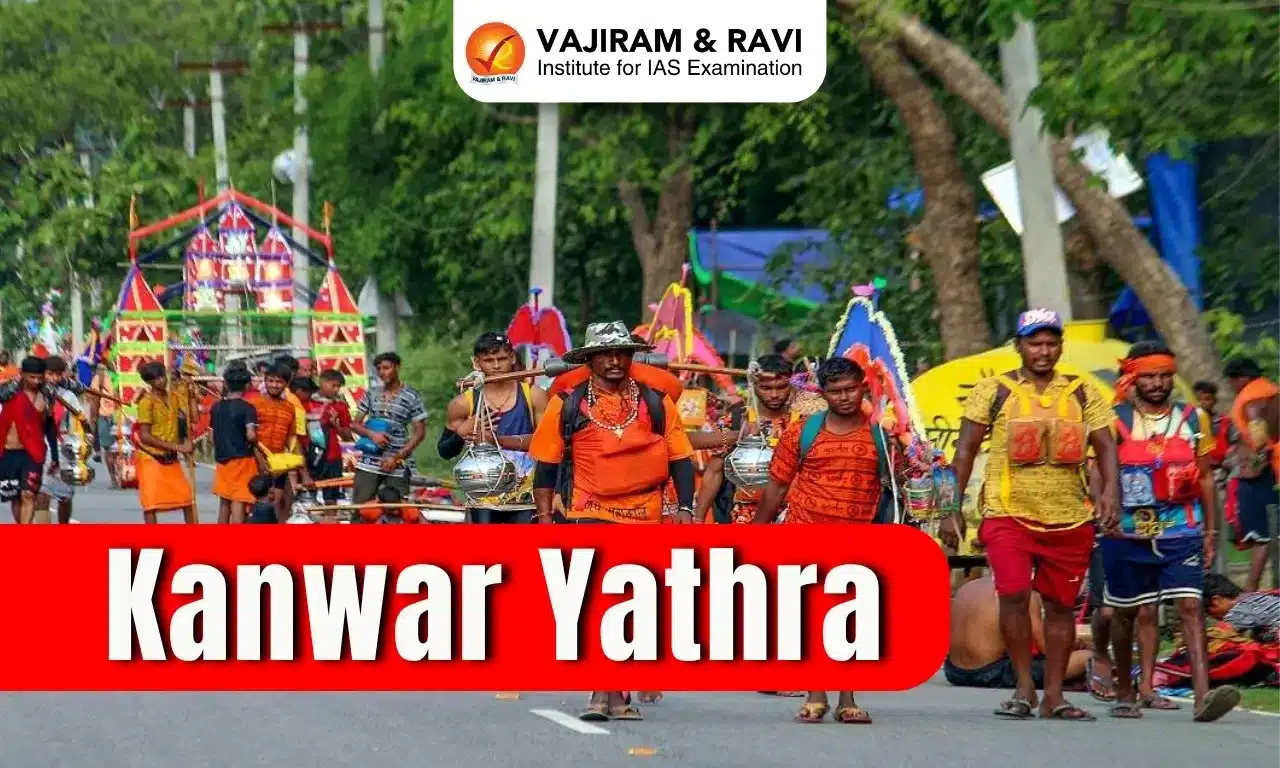Kanwar Yathra Latest News
Delhi Chief Minister recently said no nuisance will be tolerated during Kanwar Yatra, days after glass shards were found scattered along a stretch of the yatra route in Shahdara.
About Kanwar Yathra
- It’s an annual pilgrimage, held in the Hindu month of Shravan (typically July–August), where Shiva devotees (known as Kanwariyas), primarily in North India, fetch holy water from the Ganges River and carry it back to their local Shiva temples (often barefoot and walking distances of hundreds of kilometers).
- They visit the temples to offer holy water to Lord Shiva, especially on the auspicious day of Shivratri during the month of Shravan.
What happens at Kanwar Yatra?
- The term “Kanwar” refers to a special carrying apparatus, typically a bamboo pole, with two equal loads (usually pots filled with Ganga water) suspended from either end.
- This pole is balanced on the pilgrim’s shoulder. “Yatra” simply means a journey or procession.
- Thus, the Kanwar Yatra literally means the “journey with the Kanwar.”
- The core ritual of this pilgrimage is to collect sacred water, known as “Gangajal,” from River Ganga, particularly from places like Haridwar, Gaumukh (the source of the Ganges glacier), Gangotri in Uttarakhand, and Ajgaibinath Temple in Sultanganj, Bhagalpur (Bihar).
- The devotees then return by carrying Ganga water in kanwars to seek the blessings of Shiva.
- The water is offered to Shiva temples, including the 12 Jyotirlingas across India and other shrines like the Pura Mahadev Mandir and Augharnath in Uttar Pradesh, the famous Kashi Vishwanath temple, and the Baba Baidyanath Temple in Deoghar, Jharkhand. The ritual is known as Jal Abhishek.
- Devotees often carry the holy water to offer at temples in their towns and villages.
- Many pilgrims believe that once the pot is filled with holy water, it should not touch the ground.
- While carrying the water, devotees walk barefoot; some complete the pilgrimage by lying flat on the ground. Modern times have seen some adaptations, with some using cycles, motorbikes, or even vehicle convoys for parts of the journey, though the purists still prefer walking.
- Kanwariyas typically dress in saffron-colored robes, a color associated with renunciation and spirituality in Hinduism.
- Many observe fasts during the pilgrimage, and the consumption of food, water, and salt is restricted.
Source: PRINT
Last updated on November, 2025
→ Check out the latest UPSC Syllabus 2026 here.
→ Join Vajiram & Ravi’s Interview Guidance Programme for expert help to crack your final UPSC stage.
→ UPSC Mains Result 2025 is now out.
→ UPSC Notification 2026 is scheduled to be released on January 14, 2026.
→ UPSC Calendar 2026 is released on 15th May, 2025.
→ The UPSC Vacancy 2025 were released 1129, out of which 979 were for UPSC CSE and remaining 150 are for UPSC IFoS.
→ UPSC Prelims 2026 will be conducted on 24th May, 2026 & UPSC Mains 2026 will be conducted on 21st August 2026.
→ The UPSC Selection Process is of 3 stages-Prelims, Mains and Interview.
→ UPSC Result 2024 is released with latest UPSC Marksheet 2024. Check Now!
→ UPSC Prelims Result 2025 is out now for the CSE held on 25 May 2025.
→ UPSC Toppers List 2024 is released now. Shakti Dubey is UPSC AIR 1 2024 Topper.
→ UPSC Prelims Question Paper 2025 and Unofficial Prelims Answer Key 2025 are available now.
→ UPSC Mains Question Paper 2025 is out for Essay, GS 1, 2, 3 & GS 4.
→ UPSC Mains Indian Language Question Paper 2025 is now out.
→ UPSC Mains Optional Question Paper 2025 is now out.
→ Also check Best IAS Coaching in Delhi
Kanwar Yathra FAQs
Q1. The Kanwar Yatra is primarily associated with the worship of which Hindu deity?+
Q2. In which Hindu month is the Kanwar Yatra typically observed?+
Q3. What is the primary object carried by Kanwariyas during the Yatra?+
Q4. From which river do Kanwariyas collect water during the Yatra?+
Tags: kanwar yathra prelims pointers upsc current affairs upsc prelims current affairs

















